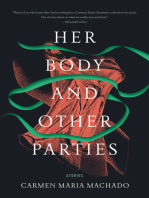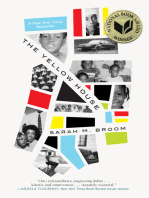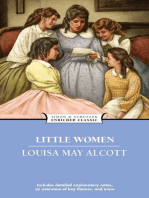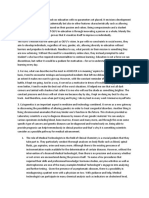Biology: Cell Theory
Biology: Cell Theory
Uploaded by
LeedCopyright:
Available Formats
Biology: Cell Theory
Biology: Cell Theory
Uploaded by
LeedOriginal Title
Copyright
Available Formats
Share this document
Did you find this document useful?
Is this content inappropriate?
Copyright:
Available Formats
Biology: Cell Theory
Biology: Cell Theory
Uploaded by
LeedCopyright:
Available Formats
1
Quarter1
Week1
Biology
Cell Theory
Your Objective:
Content Standard: Cell theory
Performance Standard: Construct a 3D model of a plant/animal/ recyclable materials
Learning Competency: Explain the postulates of the cell theory
References:
General Biology 1 ( Faltado, Ruben, Paz, de Leon, Reneecilia & Lopez, Merle, 2017) pp: 5-32 General Biology 1 (Rea,
Maria Angelica, Dequillo, Mary Zugar & Chua, Jenny Lyn, 2017) p:1-36
Let’s engage!
Activity 1
What is cell?
_______________________________________________________
Do all living things need cell?
_______________________________________________________
In your own words what is cell theory?
_______________________________________________________
Based on your own understanding, why do you need to study cell
theory?
________________________________________________________
General Biology-I Wadzna S. Kamsa
2
Let’s explain!
The Cell Theory
The cell was first discovered by Robert Hooke in 1665, which can be found
to be described in his book Micrographia. In this book, he gave 60 ‘observations’ in
detail of various objects under a coarse, compound microscope. One observation was from a
very thin slices of bottle cork. Hooke discovered a multitude of tiny pores that he named cells.
This came from the Latin word cella, meaning ‘ a small room’ and celllulae, which means
the six–sided cell of a honeycomb.
Robert Hooke
(1665)
Anton Van Leeuwenhoek is another scientist who saw these cells soon after
Hooke did. He made use of a microscope containing improved lenses that could magnify
objects almost 300-fold, or 270x. Under these microscopes, Leeuwenhoek found motile objects.
In a letter the Royal Society on October 9 , 1967, he stated that motility is a quality of life ,
therefore. These were living organisms. Leeuwenhoek named these “animalcules”, which
included protozoa and other unicellular organisms like bacteria.
Anton van Leeuwenhoek
(1674)
General Biology-I Wadzna S. Kamsa
3
The cell theory is one of the basic principles of Biology. Credits for developing cell
theory is usually given to two scientist: Theodore Schwann (1810-1882) and Matthias
Jakob Schleiden (1804-1881). While Rudolf Virchow contributed to the theory, he is
not as credited for his attributions. In 1838, Schleiden suggested that every structural part of
a plant was made up of cells or the result of cells . He also suggested cells were made by
crystallization process either within other cells or from the outside.
Matthias Schleiden Rudolf Virchow
(1838) (1855)
However, this was not an original idea of Schleiden . He claimed this theory as his
own , although Barthelemy Dumortier had stated it years before him. This crystallization
process is no longer accepted with modern cell theory. In 1839, Theodor Schwann stated
that along with plants , animals are composed of cells or the product of cells in their structures.
This was a major advancement in the field of Biology since little was known about animal
structure up to this point compared to plants . From these conclusions about plants and
animals, two of the three tenets of cell theory were postulated:
Theodor Schwann
(1839)
1. All living organisms are composed of one or more cells
2. The cell is the most basic unit of life
3. All cells arise only from pre-existing cells
The three postulates of the cell theory offer the basis on how an object is considered as a
General Biology-I Wadzna S. Kamsa
4
living thing. All living things are fundamentally made up of cell this entails no exception no
matter how simple or complex that organism is or to what environment it is exposed to or
what course of evolution it has gone through. An organism can be unicellular (one-celled) or
multicellular. A single-celled organism can be perform all the essential functions which enable
it to grow, survive, and reproduce.
Multicellular organisms are more complex in structure and function but mechanism on
how it is able to live is still the same with the simple life forms. Strongly related to this is the
second postulate which state that the cell is the basic unit of life. The cell operates similar to a
complete machine which has many compartments that perform different but interrelated and
interconnected functions.
The cell is a completely functional entity that possess characteristics which
distinguish it from inanimate objects. Finally, all cells come from pre-existing cells, which
signifies that cells cannot be spontaneously created but it will always be product of
reproduction from a pre-existing cell (Mazzarello, 1999).
Let’s explore!
Activity 2
Directions: Test your comprehension on the concept read, answer the
following questions:
1. What theory did these scientists provide evidence for?
__________________________________________________________________
___________
__________________________________________________________________
____________
2. What instrument was necessary before the cell theory could be developed?
__________________________________________________________________
___________
__________________________________________________________________
___________
General Biology-I Wadzna S. Kamsa
5
3. Whose 3 scientists directly contributed evidence for the cell theory?
__________________________________________________________________
__________
__________________________________________________________________
__________
4. How did the earlier scientists and their contributions directly affect the discoveries of later
scientists
__________________________________________________________________
_________
__________________________________________________________________
_________
__________________________________________________________________
_________
__________________________________________________________________
_________
5. List down the 3 Parts of the Cell Theory:
__________________________________________________________________
_________
__________________________________________________________________
_________
________________________________________________________________________
__________
General Biology-I Wadzna S. Kamsa
6
________________________________________________________________________
__________
Let’s practice!
Directions: Choose the name of the scientist who gave the following statements
Rudolf Virchow
Theodor Schwann
Anton Van Leeuwenhoek
Robert Hooke
Matthias Schleidein
1. Thousands of tiny empty chambers in cork are called cells (1665)
__________________________________________________________________
_______
2. Tiny living organism s are observed (1676) ___________________________
3. All plants are made up of cells (1889) _________________________________
4. All animals are made up cells (1839)
__________________________________
5. All cells come from pre-existing cells (1858) ___________________________
Directions: Complete the three basic components of the cell theory by arranging these
words in proper order. Write your constructed sentence on the space
1. ORGANISMS OF CELLS ARE ALL MORE LIVING COMPOSED OR ONE
___________________________________________________________________
___________
General Biology-I Wadzna S. Kamsa
7
2. OF BASIC CELL THE IS UNIT LIFE
___________________________________________________________________
___________
3. COME CELLS PRE-EXISTING ALL FROM CELLS
___________________________________________________________________
___________
4. In your own words explain the 3 components of cell theory ?
__________________________________________________________________
_____
________________________________________________________________________
______
Let’s evaluate!
Multiple Choice Test
Directions: Read each statement carefully and encircle the letter of the
correct answer
1. Who was the first person to see cells under the microscope and give them name?
A. Anton Van Leeuwenhoek
B. Robert Hooke
C. Theodor Schwann
D. Matthias Schleiden
2. He discovered that all structural parts of plant were made of cells, which contributed to the
development of the cell theory.
A. Anton Van Leeuwenhoek
B. Robert Hooke
C. Theodor Schwann
D. Matthias Schleiden
3. He advanced the cell theory with his conclusion that cells could only come from other cells.
A. Anton Van Leeuwenhoek
B. Rudolf Virchow
C. Theodor Schwann
General Biology-I Wadzna S. Kamsa
8
D. Robert Hooke
4. This structure serves as the outer boundary of the eukaryotic cell.
A. flagella
B. cytoskeleton
C. cell membrane
D. capsule
5. Unlikes eukaryotes, prokaryotes do not have?
A. DNA
B. cytoplasm
C. cell walls
D. a membrane bound nucleus
6. ALL of the following are main components of the cell theory, EXCEPT?
A. cell must contain DNA
B. all living things are made of cells
C. cells can only come from other cells
D. cells are basic unit of life
7. Rudolf Virchow’s observations helped to disprove was commonly held belief of the time___
A. evolution
B. the existence of molecules
C. spontaneous generation
D. atomic models
8. The word cyto means:
A. cell
B. dark
C. jelly
D. small
9. Tiny structures that carry out cell functions are collectively called_______
A. animalcules
B. organelles
C. tissues
D. ribosomes
10. Which technology essential for the development of the cell theory?
A. telescopes
B. antiseptics
C. microwaves
D. microscopes
General Biology-I Wadzna S. Kamsa
9
Let’s extend!
Look out on your surroundings, observe the different living things. List down the cell
parts or organelles that present in those living things.
General Biology-I Wadzna S. Kamsa
You might also like
- The Subtle Art of Not Giving a F*ck: A Counterintuitive Approach to Living a Good LifeFrom EverandThe Subtle Art of Not Giving a F*ck: A Counterintuitive Approach to Living a Good Life4/5 (6052)
- The Gifts of Imperfection: Let Go of Who You Think You're Supposed to Be and Embrace Who You AreFrom EverandThe Gifts of Imperfection: Let Go of Who You Think You're Supposed to Be and Embrace Who You Are4/5 (1142)
- Never Split the Difference: Negotiating As If Your Life Depended On ItFrom EverandNever Split the Difference: Negotiating As If Your Life Depended On It4.5/5 (916)
- Hidden Figures: The American Dream and the Untold Story of the Black Women Mathematicians Who Helped Win the Space RaceFrom EverandHidden Figures: The American Dream and the Untold Story of the Black Women Mathematicians Who Helped Win the Space Race4/5 (946)
- The Hard Thing About Hard Things: Building a Business When There Are No Easy AnswersFrom EverandThe Hard Thing About Hard Things: Building a Business When There Are No Easy Answers4.5/5 (360)
- Devil in the Grove: Thurgood Marshall, the Groveland Boys, and the Dawn of a New AmericaFrom EverandDevil in the Grove: Thurgood Marshall, the Groveland Boys, and the Dawn of a New America4.5/5 (273)
- The World Is Flat 3.0: A Brief History of the Twenty-first CenturyFrom EverandThe World Is Flat 3.0: A Brief History of the Twenty-first Century3.5/5 (2283)
- A Heartbreaking Work Of Staggering Genius: A Memoir Based on a True StoryFrom EverandA Heartbreaking Work Of Staggering Genius: A Memoir Based on a True Story3.5/5 (233)
- Basic Immunology Functions and Disorders of The Immune System 3rd Edition Abul K. Abbas Download PDF100% (15)Basic Immunology Functions and Disorders of The Immune System 3rd Edition Abul K. Abbas Download PDF81 pages
- 2022 AQA GCSE (Higher) Biology Paper 1 MSNo ratings yet2022 AQA GCSE (Higher) Biology Paper 1 MS30 pages
- Sumaira's Natural Selection Bird SimulationNo ratings yetSumaira's Natural Selection Bird Simulation6 pages
- Chemistry Project: By: Muskan Mishra CLASS: 12 Science YEAR: 2021-2022 ROLL NO.:12230No ratings yetChemistry Project: By: Muskan Mishra CLASS: 12 Science YEAR: 2021-2022 ROLL NO.:1223019 pages
- 11th Biology Half Yearly Exam 2024 Answer Key Chengalpattu District English Medium PDF DownloadNo ratings yet11th Biology Half Yearly Exam 2024 Answer Key Chengalpattu District English Medium PDF Download11 pages
- Epithelial Tissue Review Worksheet KEY - PHYSIONo ratings yetEpithelial Tissue Review Worksheet KEY - PHYSIO3 pages
- CBSE Class 12 Science Chapter 15 Biodiversity and Conservation NotesNo ratings yetCBSE Class 12 Science Chapter 15 Biodiversity and Conservation Notes4 pages
- Chapter 3 Cell Division - Print - QuizizzNo ratings yetChapter 3 Cell Division - Print - Quizizz8 pages
- Qualitative and Quantitative Determination of EnzymesNo ratings yetQualitative and Quantitative Determination of Enzymes28 pages
- Biotic Interactions and Plant-Pathogen AssociationsNo ratings yetBiotic Interactions and Plant-Pathogen Associations15 pages
- CRISPR A Machine-Generated Literature Overview (Ziheng Zhang, Ping Wang, Ji-Long Liu) (Z-Library)No ratings yetCRISPR A Machine-Generated Literature Overview (Ziheng Zhang, Ping Wang, Ji-Long Liu) (Z-Library)245 pages
- Current Trends in Monoclonal Antibody Development and Manufacturing - 2010No ratings yetCurrent Trends in Monoclonal Antibody Development and Manufacturing - 2010348 pages
- The Subtle Art of Not Giving a F*ck: A Counterintuitive Approach to Living a Good LifeFrom EverandThe Subtle Art of Not Giving a F*ck: A Counterintuitive Approach to Living a Good Life
- The Gifts of Imperfection: Let Go of Who You Think You're Supposed to Be and Embrace Who You AreFrom EverandThe Gifts of Imperfection: Let Go of Who You Think You're Supposed to Be and Embrace Who You Are
- Never Split the Difference: Negotiating As If Your Life Depended On ItFrom EverandNever Split the Difference: Negotiating As If Your Life Depended On It
- Hidden Figures: The American Dream and the Untold Story of the Black Women Mathematicians Who Helped Win the Space RaceFrom EverandHidden Figures: The American Dream and the Untold Story of the Black Women Mathematicians Who Helped Win the Space Race
- The Hard Thing About Hard Things: Building a Business When There Are No Easy AnswersFrom EverandThe Hard Thing About Hard Things: Building a Business When There Are No Easy Answers
- Elon Musk: Tesla, SpaceX, and the Quest for a Fantastic FutureFrom EverandElon Musk: Tesla, SpaceX, and the Quest for a Fantastic Future
- The Emperor of All Maladies: A Biography of CancerFrom EverandThe Emperor of All Maladies: A Biography of Cancer
- The Yellow House: A Memoir (2019 National Book Award Winner)From EverandThe Yellow House: A Memoir (2019 National Book Award Winner)
- The Little Book of Hygge: Danish Secrets to Happy LivingFrom EverandThe Little Book of Hygge: Danish Secrets to Happy Living
- Devil in the Grove: Thurgood Marshall, the Groveland Boys, and the Dawn of a New AmericaFrom EverandDevil in the Grove: Thurgood Marshall, the Groveland Boys, and the Dawn of a New America
- The World Is Flat 3.0: A Brief History of the Twenty-first CenturyFrom EverandThe World Is Flat 3.0: A Brief History of the Twenty-first Century
- The Sympathizer: A Novel (Pulitzer Prize for Fiction)From EverandThe Sympathizer: A Novel (Pulitzer Prize for Fiction)
- A Heartbreaking Work Of Staggering Genius: A Memoir Based on a True StoryFrom EverandA Heartbreaking Work Of Staggering Genius: A Memoir Based on a True Story
- Team of Rivals: The Political Genius of Abraham LincolnFrom EverandTeam of Rivals: The Political Genius of Abraham Lincoln
- On Fire: The (Burning) Case for a Green New DealFrom EverandOn Fire: The (Burning) Case for a Green New Deal
- The Unwinding: An Inner History of the New AmericaFrom EverandThe Unwinding: An Inner History of the New America
- Basic Immunology Functions and Disorders of The Immune System 3rd Edition Abul K. Abbas Download PDFBasic Immunology Functions and Disorders of The Immune System 3rd Edition Abul K. Abbas Download PDF
- Chemistry Project: By: Muskan Mishra CLASS: 12 Science YEAR: 2021-2022 ROLL NO.:12230Chemistry Project: By: Muskan Mishra CLASS: 12 Science YEAR: 2021-2022 ROLL NO.:12230
- 11th Biology Half Yearly Exam 2024 Answer Key Chengalpattu District English Medium PDF Download11th Biology Half Yearly Exam 2024 Answer Key Chengalpattu District English Medium PDF Download
- CBSE Class 12 Science Chapter 15 Biodiversity and Conservation NotesCBSE Class 12 Science Chapter 15 Biodiversity and Conservation Notes
- Qualitative and Quantitative Determination of EnzymesQualitative and Quantitative Determination of Enzymes
- Biotic Interactions and Plant-Pathogen AssociationsBiotic Interactions and Plant-Pathogen Associations
- CRISPR A Machine-Generated Literature Overview (Ziheng Zhang, Ping Wang, Ji-Long Liu) (Z-Library)CRISPR A Machine-Generated Literature Overview (Ziheng Zhang, Ping Wang, Ji-Long Liu) (Z-Library)
- Current Trends in Monoclonal Antibody Development and Manufacturing - 2010Current Trends in Monoclonal Antibody Development and Manufacturing - 2010






































































